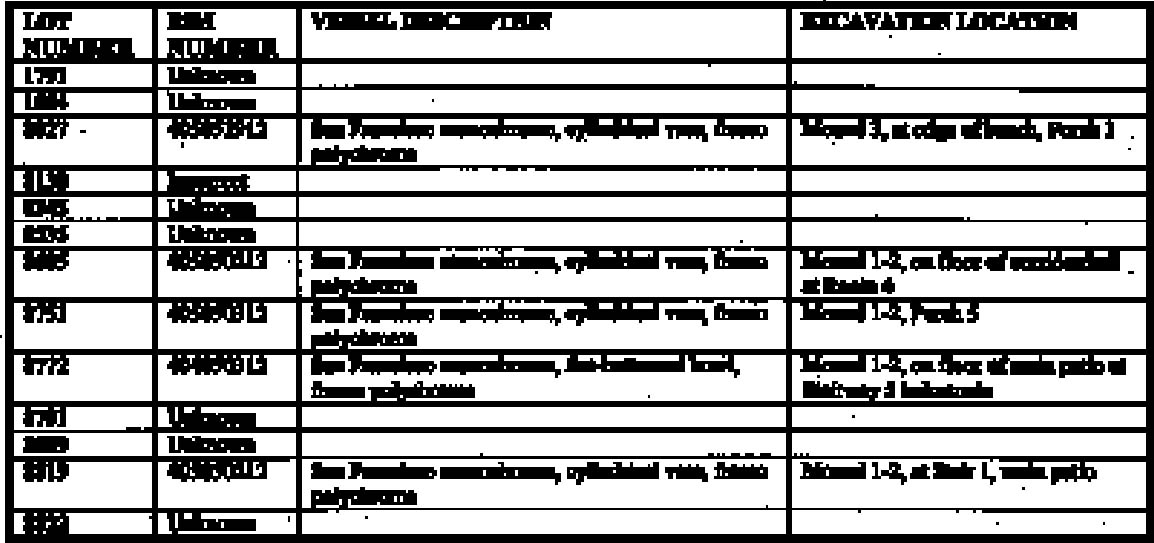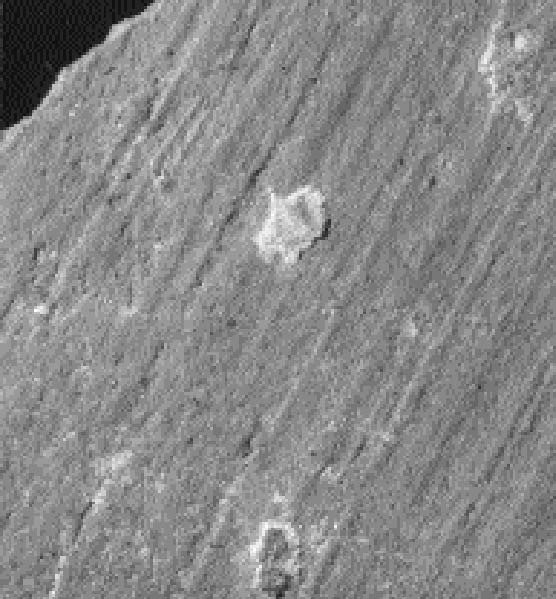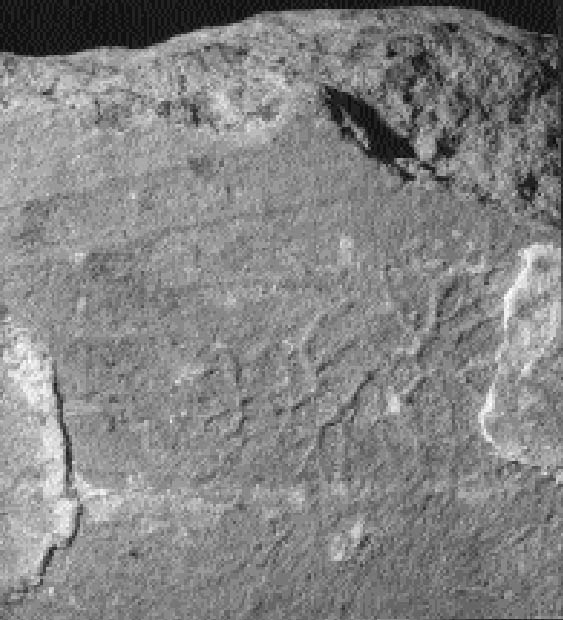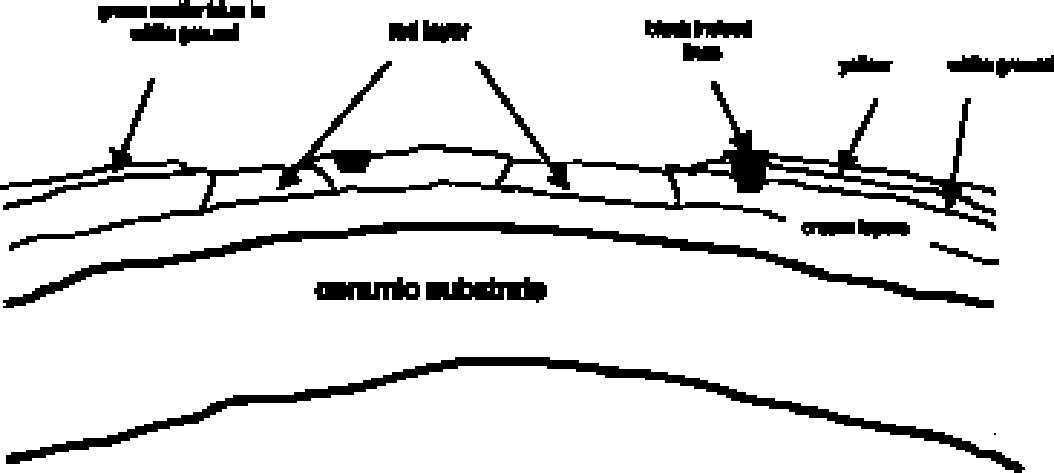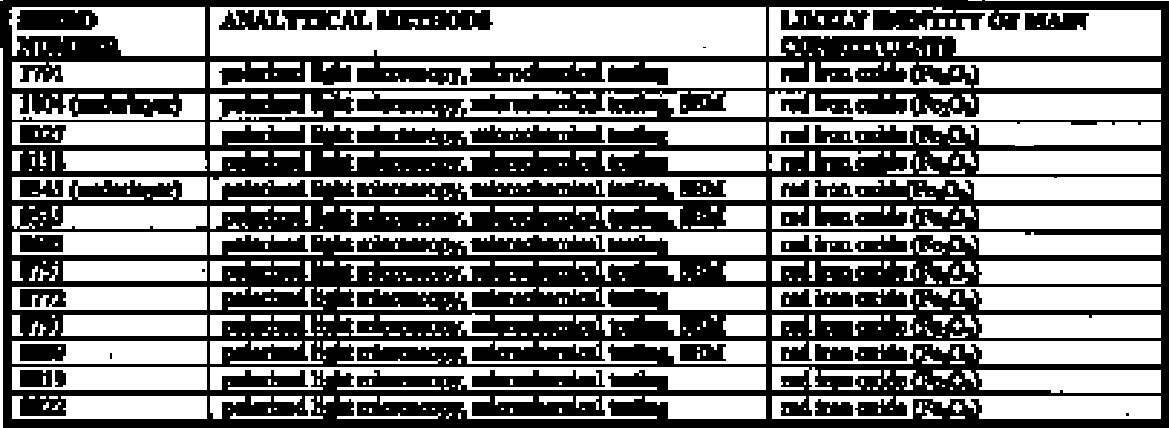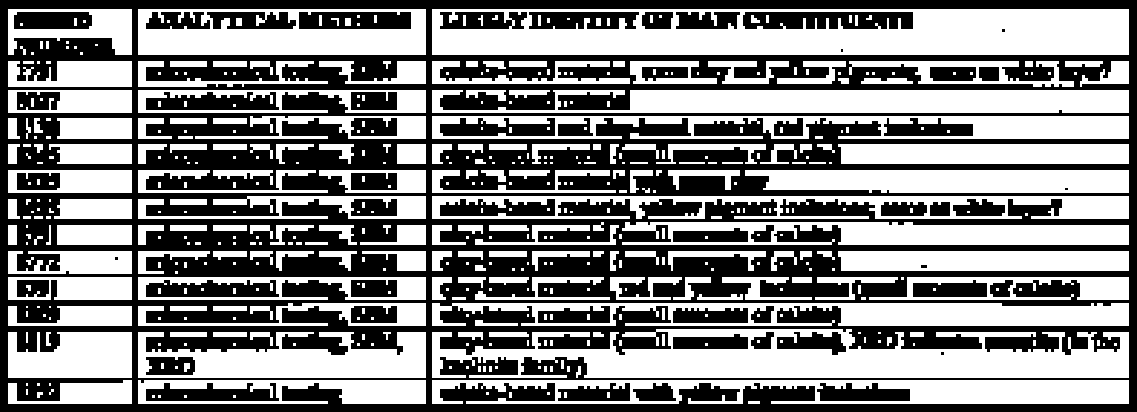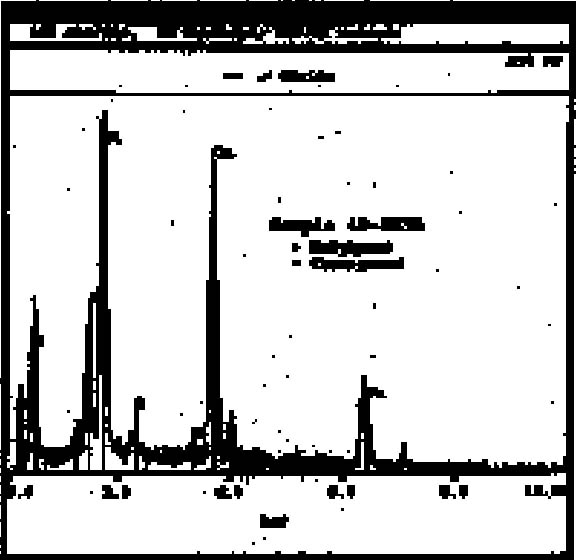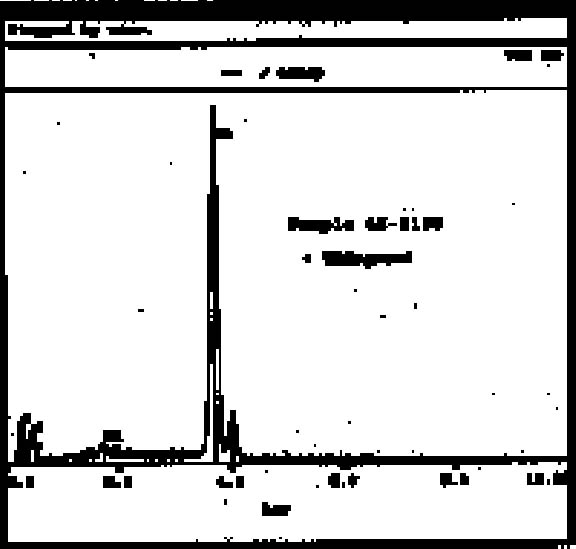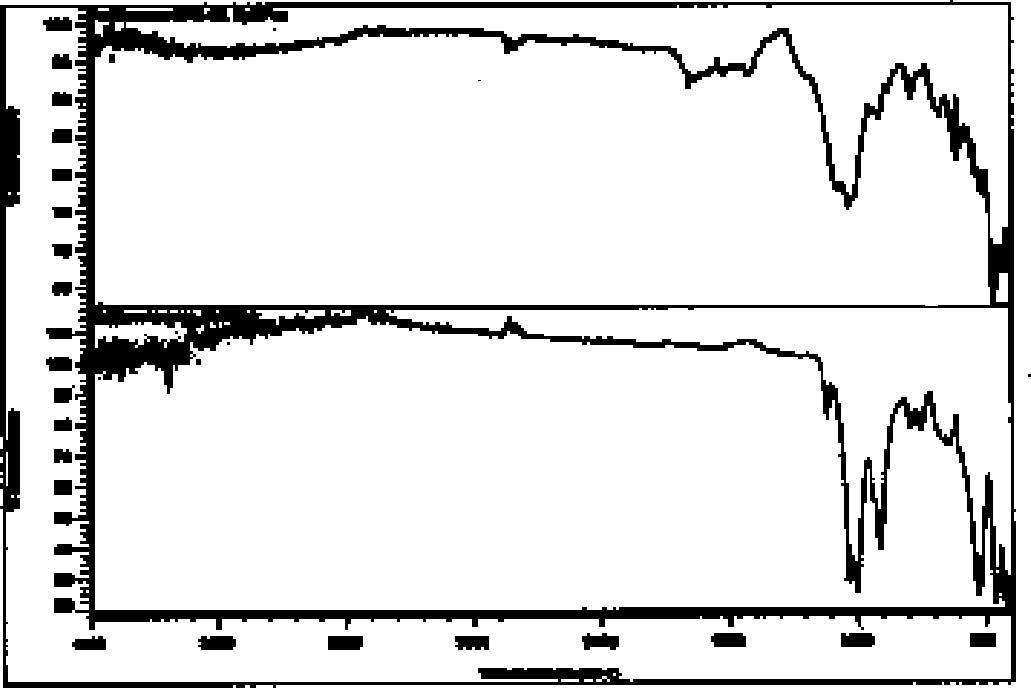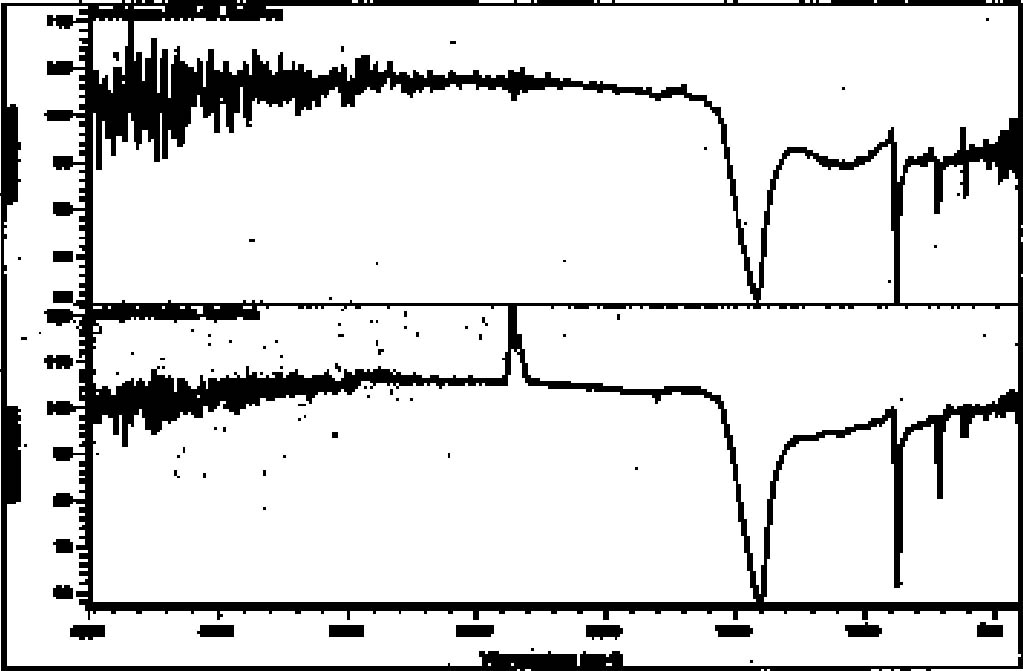STUCCOED TRIPOD VESSELS FROM TEOTIHUAC�N: AN EXAMINATION OF MATERIALS AND MANUFACTUREJessica M. Fletcher
ABSTRACT—This study was conducted with the goal of characterizing a specific group of polychrome stuccoed ceramic sherds from the Maquixco Bajo archaeological site at Teotihuac�n, Mexico. Teotihuac�n is located northeast of Mexico City and dates to the Classic Period, ca. 150–750 A.D. Analysis included pigment identification, stucco identification, characterization of the ceramic surface preparation, as well as further investigation into binders and the technology of application. The layered structure of the stucco decoration is described. Analytical techniques used included scanning electron microscopy (SEM), x-ray powder diffraction (XRD), Fourier transform infrared spectroscopy (FTIR), microchemical testing, and polarized light microscopy. Results indicate that red and yellow pigments are primarily iron oxides, blue and green pigments are mixtures of azurite and malachite with chrysocolla, and most black pigments contain charcoal black. Ground layers are made up of calcite or clay, as well as mixtures of the two materials. Calcite is proposed as a binder. TITRE—Les vaisseaux � tr�pied recouverts de stuc provenant de Teotihuac�n: un examen des mat�riaux et de la fabrication. R�SUM�—Cette �tude a �t� entreprise afin de caract�riser un groupe sp�cifique de tessons en c�ramique recouverts de stuc polychrome provenant du site arch�ologique de Maquixco Bajo � Teotihuac�n, au Mexique. Teotihuac�n est situ� au nord-est de Mexico et date de la p�riode classique, soit d'environ 150-750 apr. J. C. L'analyse s'est port�e sur l'identification des colorants et du stuc, la caract�risation des couches de surface de la c�ramique, ainsi qu'une recherche sur les liants et les techniques d'application. La stratigraphie des couches d�coratives en stuc est aussi d�crite. Les m�thodes analytiques utilis�es inclurent le microscope � balayage �lectronique, la diffraction aux rayons-X, la spectroscopie � l'infrarouge par transform�e de Fourier, des tests microchimiques, et le microscope polariseur. Les r�sultats indiquent que les colorants rouges et jaunes sont surtout des oxydes de fer, les colorants bleus et verts sont des m�langes d'azurite et de malachite avec de la chrysocolle, et la plupart des colorants noirs contiennent du noir de charbon de bois. Les couches de pr�paration se composent de calcite ou d'argile, ou encore d'un m�lange de ces deux mat�riaux. On suppose que la calcite est utilis�e comme un liant. TITULO—Vasijas tr�pode estucadas provenientes de Teotihuac�n: un analisis de sus materiales y manufactura. RESUMEN—Este estudio fue realizado con el objetivo de caracterizar un grupo espec�fico de fragmentos de cer�mica estucada y policromada del sitio arqueol�gico Maquixco Bajo en Teotihuac�n, M�jico. Teotihuac�n est� localizada al nordeste de la Ciudad de M�jico y data del per�odo Cl�sico, ca.150-750 A.C. El an�lisis incluy� la identificaci�n del pigmento y del estuco, la caracterizaci�n de la preparaci�n de la superficie de la cer�mica, as� como una investigaci�n sobre los ligantes y la tecnolog�a de aplicaci�n. Se describe la estructura estratificada de la decoraci�n del estuco. Las t�cnicas anal�ticas utilizadas comprendieron microscop�a de barrido electr�nico (SEM), difracci�n de rayos X (XRD), espectroscopia infrarroja con transformada de Fourier (FTIR), ensayo microqu�mico y microscop�a con luz polarizada. Los resultados indican que los pigmentos rojos y amarillos son principalmente �xidos de hierro, los pigmentos azules y verdes son mezclas de azurita y malaquita con crisocola, en tanto que la mayor�a de los pigmentos negros contienen carb�n. Las capas de base est�n compuestas por calcita o arcilla, as� como mezclas de ambos materiales. Se propone como hip�tesis que el ligante es calcita. 1 INTRODUCTIONStuccoed cylindrical tripod vessels from Teotihuac�n can be found in museums around the world, and yet they remain objects surrounded by mystery. Most have been excavated from elaborate burials, but repairs on the vessels such as crack-lacing suggest that they had a function during life as well (Conides 1997). It is not even certain who applied the delicate While much has been written on the subject of the mural paintings from Teotihuac�n, comparatively little analytical data have been published on stuccoed cylindrical tripod vessels. Notable studies include Castillo Tejero's (1968) survey of decorative techniques and pigment types that included five samples from Teotihuac�n. Shepard's appendix to Excavations at Kaminaljuyu, Guatemala (1946) also includes descriptions of sherds from Teotihuac�n. She discusses analyses of ceramic body, stucco, and pigments. Specific to analysis of the clay matrix is Kolb's “Analyses of Archaeological Ceramics from Classic Period Teotihuac�n, Mexico, A.D. 150–750.” Published in 1997, this paper discusses the pastes and aplastics of Teotihuac�n ceramic artifacts. Both the small number of literature sources and the materials variation that they indicate clearly demonstrate the need for further analytical research on stuccoed tripod vessels. This study was conducted with the goal of characterizing a specific group of stuccoed pottery fragments from Teotihuac�n. Thirteen representative sherds (fig. 1) were selected from approximately 150 that were available from the archaeological site known as Maquixco Bajo (also designated TC-8). Maquixco Bajo was a large period village situated outside the western boundary of urban Teotihuac�n. Five excavations had been conducted at this residential area during the 1961 and 1962 field seasons (Sanders 1994). The 150 available sherds had all been stored together loosely in a box, so pigment transference was a certainty. Consequently, the primary criterion for the sample selection was to isolate those sherds that exhibited the least evidence of disruption. This culling narrowed down the choices considerably and did not allow for a random sampling. Sherds exhibiting
Analysis of the 13 sherds included pigment identification, stucco identification, characterization of the ceramic surface preparation, as well as further investigation into binders and the technology of application. The techniques employed for analysis included scanning electron microscopy (SEM), microchemical testing, polarized light microscopy, x-ray powder diffraction (XRD), and Fourier transform infrared spectroscopy (FTIR). To place the results of this research in context, a brief introduction to Teotihuac�n is necessary.
2 HISTORICAL BACKGROUNDThe ancient city of Teotihuac�n, Mexico, was the most influential of its time in Mesoamerica and, in 600 A.D., the sixth-largest city in the world. For some perspective, at this time Constantinople was the largest city with a population of approximately 500,000 and Alexandria the fifth largest (Chandler and Fox 1974). During the Classic Period, which spans from approximately 150 to 750 A.D., Teotihuac�n exercised widespread political, economic, and religious control throughout Mesoamerica while supporting a population of at least 125,000 to 150,000 inhabitants (Berrin and Pasztory 1993; Kolb 1997). Immigrant groups from places such as Oaxaca and Veracruz also played a role in this vast urban center and were housed in barrios, or neighborhoods, along the outskirts of the city (Berrin and Pasztory 1993). Teotihuac�n is perhaps most famous for its monumental architecture, much of which was decorated with painted wall murals. Unlike stuccoed vessels, the mural paintings of Teotihuac�n are widely studied, and the materials used are well documented. When artisans first started applying stucco to pots, they reused vessels with other completed decorative finishes, such as the prized trade ware known as thin orange and those with carved plano-relief. By 550 A.D. the surfaces of some vessels were purposely roughened before firing in preparation for receiving the stucco (Conides 1997). While it is likely that the roughening was performed by the same ceramic artisans responsible for carved plano-relief, it is not certain if they were the ones who then applied the decorative stucco layers. It is possible that stuccoed vessels were produced from start to finish in ceramic workshops, or that the fired vessels were decorated as a subspecialty of mural painting. It was hoped that this study might unearth new clues on the subject. 3 EXAMINATIONThe first step in this research was to perform a visual examination of each sherd in order to characterize the structure of the stucco layers. Starting with the ceramic substrate, the process that was observed for producing a stucco-decorated vessel will be outlined. The treatment of the ceramic surface beneath the stucco was examined, when accessible, using a Wild M7A stereomicroscope. For the purposes of this study, the term “ground” refers only to the base layers of applied stucco decoration and not to the fired clay substrate. In 7 of the 13 sherds, the ceramic surfaces appear roughened specifically to receive decoration prior to firing. The rounded edges and surfaces (fig. 2) of the marks suggest that they were made while the vessels were still fairly wet. On two of the sherds (8027 and 8535), what appear to be the marks of fingers in wet clay (fig. 3) are visible. A crisper appearance of scrape marks would be more indicative of leather-hard clay. On three of the sherds, not enough of the surface was visible to characterize preparation techniques.
In some cases, stucco decoration was applied over surfaces not originally intended for this type of decoration. In most cases, the first actual step of stucco decoration began with the application of a cream-colored base coat. Figure 4 illustrates the layered structure of stucco decoration observed on the majority of sherds in this study. Red design elements were painted next over the cream base. A second layer of cream-colored material was applied in the negative spaces to bring them up roughly level with the red. There are many examples in which this second cream-colored layer clearly overlaps the red, helping to confirm the order of application. The one exception to the pattern was noted on the sherd (1804) that was previously decorated with a slip resist pattern. In this case, a thin blue paint layer was applied directly over the slip pattern. Shepard noted a very similar case in which green paint was applied directly over a red wash coat (1946). When a pigment other than red was to be applied, a second, white ground layer was painted on locally over the cream ground, and then the colored paint was applied. This was particularly true for yellow paint. With the green and blue paints, the white seems to be more of a bulking agent than a separate layer. There are also examples in which pigments and white ground were painted directly over both red and cream design elements, perhaps representing artist's changes. For most of the sherds, the application of black outlines was the last step in stucco decoration. Incisions that varied in both width and depth were first made to receive the paint, sometimes cutting through pigment layers and into the applied ground. 4 EXPERIMENTALOnce the layered structure of stucco decoration was clearly established, analytical techniques were employed to identify the materials used. The results are summarized in tables 2 through 8.
4.1 SAMPLING PROCEDURESamples were taken from the stucco decoration by two methods. For SEM and FTIR, a surgical scalpel was used to cut through all layers of the stucco and remove a small fragment. These samples ranged in size from approximately 0.5 mm to 1.5 mm at the widest point. In all other cases, particular paint and ground layers were isolated. A surgical scalpel was used to remove a small amount of material (smaller than a pinhead) from the surface of the area of interest. 4.2 SCANNING ELECTRON MICROSCOPY4.2.1 TechniqueThirteen samples were examined by SEM/EDX (energy dispersive x-ray spectroscopy) at the South 4.2.2 ResultsCopper-containing green pigments and ironcontaining red and yellow pigments were detected by the scanning electron microscope. From the 13 sherds, 6 samples containing red pigment were examined. All showed a peak for iron (see fig. 5 for representative spectrum). Mercury surprisingly was not detected, indicating the absence of the pigment cinnabar. Literature sources have long associated cinnabar with many ceramic traditions in Mesoamerica, including stuccoed tripod vessels (Conides 1997). The pigment is symbolically connected with burial and the underworld (Taylor 2000) and is less common on other forms of art from Teotihuac�n such as mural paintings, where hematite constitutes the red paint (Conides 1997). This distribution is also logical since the expense of cinnabar would likely limit its use to small areas such as those on ceramics. Examination of the ground layers showed variation in material proportions, but it also indicated a general trend in application. The white top ground layer, when present, seemed to be primarily calcite (see fig. 6 for representative spectrum). In addition to clay inclusions in this layer, the strong peak for silica found in green pigment–containing samples suggested chrysocolla, a copper silicate sometimes associated in nature with malachite and azurite, basic copper carbonates. The composition of the cream ground was not as consistent, with variable proportions of silicate and calcareous material present.
4.3 POLARIZED LIGHT MICROSCOPY4.3.1 TechniqueSince not all examples of pigments were examined by scanning electron microscopy, further investigation was needed to make identifications. 4.3.2 ResultsThe small particle sizes and the high levels of silicate and calcareous material in the samples made their identification by microscopy difficult. Crystals of malachite, azurite, chrysocolla, and the red and yellow iron oxides were easily identified, but many of the smaller particles present could not be positively identified. While all the reds appeared to contain iron oxides, it is possible that there were undetected small amounts of cinnabar present in those samples for which it was not ruled out by scanning electron microscopy. Black paints were examined by polarized light microscopy only. The splintery appearance in all but one of the 11 samples strongly indicated charcoal black as the pigment. Literature sources indicated four likely possibilities: various forms of carbon black (Shepard 1946), manganese black, sphalerite (ZnS), and bitumen (Magaloni et al. 1995). In Castillo Tejero's study (1968), the black is described as a mixture of carbon and clay. Shepard's study indicates a fine carbon black mixed with calcite, as well as charcoal mixed with white clay. The one inconclusive black paint is from one of the sherds (1804) with previous decoration, and it still has not been identified. The pigment is very fine with many agglomerates, but was not characterized further. Manganese is a possibility, as it was detected on SEM spectra for a neighboring red sample. 4.4 MICROCHEMICAL TESTING4.4.1 TechniqueMicrochemical testing was used as a complementary method with polarized light microscopy in this study. Sixty-three samples were taken from the same locations used for polarized light microscopy. Reference samples were created by mixing each likely pigment with calcite and kaolin to approximate the calcium and silicate materials found in the unknown samples. These light-colored materials were added to the pigment until an approximate match to the color of the unknown was achieved. Microchemical tests were then performed on both the reference and unknown pigment samples. Pure kaolin and calcite were used as references when ground materials were tested. The microchemical tests used in this analysis are described in table 9.
4.4.2 ResultsThe microchemical test for iron was positive in 11 out of 13 red paint samples. In the 2 inconclusive cases, however, the ratio of red pigment to ground material in the sample may have been too small for a positive to be detected. Even the known mixture of iron red and ground gave only a weak positive. The 2 samples that gave inconclusive iron results were further tested with nitric acid to distinguish between hematite, which is unaffected, and cinnabar, which readily dissolves. In both cases, the red pigments appeared unaffected by the treatment, indicating that if cinnabar is present, it is only in very small amounts. During preliminary testing, a positive result for mercury using the reference pigment mixture could not be achieved. The test for mercury was not, therefore, conducted. Again, it is likely that the ratio of red pigment to ground in the sample was insufficient to produce a detectable positive result. The microchemical test for iron in yellow pigments was less conclusive than with red pigments. Five of the 10 samples gave positive tests for iron. Four of the yellow paint samples did not show positive results even though previous analytical methods indicated the presence of yellow iron oxide. The last sample was too small to test. None of the microchemical tests for copper among green and blue-green pigments gave positive results. While frustrating, the result was not totally unexpected since these colors were usually mixed with white ground, making the ratio of pigment to ground even smaller than with the red and yellow pigments. Since previous methods suggested the presence of malachite and azurite, another test was conducted to differentiate between basic copper carbonates and the copper silicate chrysocolla. With the application of hydrochloric acid, malachite and azurite immediately dissolve, while chrysocolla only slowly decolorizes. This testing suggested the presence of chrysocolla in conjunction with malachite in three of the five green samples and in both of the blue samples. The results of the SEM analysis of these samples provided corroborating evidence for the presence of chrysocolla. The SEM results from the grounds also corroborated the results of microchemical testing. When tested with 3 molar hydrochloric acid, calcite-based material immediately dissolved with violent evolution of carbon dioxide gas. Clay-based ground material was unaffected by the acid. While the white calcite layers appeared relatively free of clay, calcite was apparent in small quantities in most of the claybased layers. Red and yellow pigments were detected in both types of ground layers. In fact, in some cases what was presumed to be a clay layer because of its creamy color turned out to be a pigmented calcite layer. In the case of sherd 1804 (with the red-and-black decorative layer beneath the blue-green paint), no distinct ground layer was detectable. Instead, a white material was fairly well impregnated with blue-green pigments. Polarized light microscopy suggested azurite as a component. After treatment with dilute acid (which would dissolve azurite), only yellow and green pigments remained. The white material was identified as calcite. It is likely that the green is chrysocolla and the yellow is an iron oxide. 4.5 X-RAY POWDER DIFFRACTION4.5.1 TechniqueIn order to confirm the specific chemical structure of materials and to clarify samples that were still inconclusive, several samples were examined by XRD. Seven samples were chosen that were deemed representative of pigments and ground layers. After gentle crushing in an agate mortar and pestle, the sample was placed in a 0.3 mm capillary tube, and powder photographs were obtained by the Debye-Scherrer method.2 4.5.2 ResultsDiffraction data were not as conclusive as anticipated. Six of the seven powder photographs suggested mixtures of materials, a problem encountered previously in this research. It was not possible to individually identify the various components within the time limits of this project. The cream ground 4.6 FOURIER TRANSFORM INFRARED SPECTROSCOPY4.6.1 TechniqueSix stuccoed sherds were selected for analysis by FTIR to search for the presence of organic gum binders. New sample locations that contained multiple layers of surface decoration were chosen. It was felt that organic binders, if present, would most likely be encountered in areas with multiple applications. As this was a very general survey, it was not deemed necessary to obtain FTIR spectra on separate layers. The samples were analyzed3 using a Nicolet FTIR equipped with a SplitPea microsample accessory. 4.6.2 ResultsThis analysis did not produce any definitive evidence for the presence of organic binders, but it did help to confirm the previous findings in this study that both silicate and calcareous materials were used for ground composition on the sherds. The spectra recorded for two samples (8772–69 and 8809–71) were not strong enough to be interpreted. The spectra for one sample (8819–72) showed a strong peak for carbonate in the 1450–1410 cm-1 range and a medium peak at 880–860 cm-1, which is consistent with calcite. The spectra recorded for the other three samples (8345–65, 1804–62, and 8819–72) showed peaks in the range associated with silicates, 1100–900 cm-1. While the bands varied in intensity, the strongest peak was seen in all three examples from approximately 1100–950 cm-1 and a weaker peak at 930–900 cm-1. Representative comparisons are made between spectra recorded for Teotihuac�n samples and reference spectra for calcite and kaolin in figures 7 and 8.
5 DISCUSSIONThe results of the many analytical techniques performed for this study are summarized in tables 2–8. The only red pigment identified was red iron oxide. Green pigments were identified as the basic copper carbonate, malachite, and the copper silicate, chrysocolla. Although the malachite was sometimes used alone, chrysocolla was found only in combination with other pigments. Azurite, another basic copper carbonate, was identified as the blue pigment, but both blue paint samples also contained significant amounts of chrysocolla and the hydrated yellow iron oxide, limonite. Yellow paint samples were identified as primarily limonite. Black pigments were identified in all but one case as being charcoal black. The white ground layers were in all cases calcite-based, while the cream-colored ground was calcite, clay, or a mixture of the two materials. It should be noted that varying degrees of calcareous material were detected in almost all of the pigment and ground samples. According to Shepard's study, the calcite found in most of those pigment samples may represent the addition of slaked lime that has recarbonated upon exposure to the atmosphere, hence binding the pigments (Shepard 1946). It is possible that lime washes were intentionally mixed with the pigments, a method somewhere in between the painting techniques of true fresco and a secco. Since the calcite crystals can grow in the last stage of evaporation, they would already be at contact points between the mineral grains, and very little calcareous material would be needed (Torraca 1982). With further study, the actual nature of the binding mechanism may become apparent. It is quite possible that the addition of gum binders may not have been necessary. While many questions have been answered in this study concerning the materials and manufacture of stuccoed tripod vessels, the identity of the artisans still has not been confirmed. As stated earlier, some scholars have proposed that stuccoed tripod vessels were first constructed and fired in ceramic workshops and then decorated as a subspecialty of the mural painting workshops (Evans and Berlo 1992). Conides (1997) believes it more likely that ceramic artisans incorporated stucco decoration into their repertoire. Supporting evidence for this theory includes comparison of decorative motifs. Conides has found Since this study showed that the use of cinnabar is not as diagnostic as previously thought in distinguishing ceramic artisans from mural painters, sherds that were identified as having clay grounds were further investigated. The use of clay as a ground has been found in examples widely distant in Mesoamerica (Shepard 1946). Clay base coats are also very similar in concept to the application of decorative slips on the surfaces of vessels. Their presence on some but not all of the sherds in this study could represent a bridge between the traditional techniques of potters and the development of applying stucco to ceramics. The examples of pigmented calcite ground are very similar in appearance to clay but likely would have been even more durable. Perhaps they represent an improvement in technology, while still maintaining visual continuity. Examination revealed that more of the roughened sherds are, indeed, associated with calcite-based cream grounds than with clay-based ones. These data are in no way conclusive, however, especially since the ceramic surface is not visible on three sherds. As well, more of the nonroughened sherds also are associated with calcite grounds. This finding could be partially explained by the fact that not all vessels after 550 A.D. were roughened. Stucco was still applied in some cases over vessels with other completed decorative finishes (Conides 1997). Clearly, 10 sherds do not constitute a large enough sample size for a correlation to be made. This question would make an interesting topic for further research. 6 CONCLUSIONSTo date, only one possible manufacturing area for cylindrical tripod vessels has been identified through excavation. Without physical evidence of the tools and materials used in these workshops, the main source of information on technology and manufacture is the vessels and sherds themselves (Conides 1997). The 13 sherds examined in this study have added considerably to the body of knowledge. Through analysis, the layered structure of the stucco decoration was specifically detailed, and the materials used were identified. It was also discovered that cinnabar is not as widely used on cylindrical tripod vessels as previously thought. Clearly there are variations in the materials used for stucco decoration, justifying further research on the subject. It would be of particular interest to the author to pursue more in-depth analysis of sherds with red applications underneath the stucco. The scope could also be broadened to include more cultural interpretation. It is possible that other trends in materials and manufacture will become apparent. ACKNOWLEDGEMENTSThe author would like to thank Professor Cynthia Conides, from the Buffalo State College History Department, for all of her help and for bringing this project to my attention;William Sanders, professor of anthropology at Pennsylvania State University, for permission to sample the sherds; Samantha Alderson, at the American Museum of Natural History, for providing essential background information and bibliographies on stuccoed murals and ceramics from Mesoamerica; Charles Kolb, at the National Endowment for the Humanities, for his guidance in editing; and Peter Bush at the South Campus Instrumentation Center for the SEM analysis. In the Buffalo State College Art Conservation Department, I am especially indebted to Professors F. Christopher Tahk and Ruth Norton for their tireless efforts. NOTES1. A Hitachi S-4000 scanning electron microscope with a Princeton Gamma-Tech IMIX System was used to perform elemental analysis. 2. Powder photographs were obtained by the Debye-Scherrer method using a Philips PW 1720 x-ray generator at 40 kV/20 mA. Exposure time was 45 minutes for all samples except for 8791–108, in which case the exposure took one hour. 3. FTIR spectra were recorded using a Nicolet Magna–IR 560 spectrometer with OMNIC software and a SplitPea microsample accessory at 2 lbs. pressure. Samples 1804–62, 8345–65, and 8772–69 were collected with 32 scans, while samples 8685–67, 8809–71, and 8819–72 were collected using 64 scans. REFERENCESBerrin, K., and E.Pasztory, eds.1993. Teotihuac�n: Art from the city of the gods. New York: Thames and Hudson. Castillo Tejero, N.1968. Algunas t�cnicas decorativas de la cer�mica arqueol�gica de M�xico. Serie Investigaciones 16. Mexico City: Instituto Nacional de Antropolog�a e Historia (INAH). Chandler, T., and G.Fox. 1974. 3000 years of urban growth. New York: Academic Press. Conides, C. A.1997. Social relations among potters in Teotihuac�n, Mexico. Museum Anthropology21:39–54. Evans, S. T., and J. C.Berlo. 1992. Teotihuac�n: An introduction. In Art, ideology, and the city of Teotihuac�n, ed. J. C.Berlo. Symposium at Dumbarton Oaks, October 8–9, 1988. Washington, D. C.: Dumbarton Oaks Research Library and Collection. 1–26. Kolb, C. C.1988. Classic Teotihuac�n copoid wares: Ceramic ecological interpretations. In Ceramic ecology revisited, 1987: The technology and socioeconomics of pottery, ed. C. C.Kolb. Oxford: British Archaeological Reports International Series 436: 345–448. Kolb, C. C.1997. Analyses of archaeological ceramics from classic period Teotihuac�n, Mexico, A. D. 150–750. In Materials issues in art and archaeology, vol. 5. Materials Research Society Symposium Proceedings 462, ed. P. B.Vandive. et al. 247–62. Magaloni, D., R.Newman, L.Ba�os, V.Casta�o, R.Pancella, and Y.Fruh. 1995. An analysis of Mayan painting techniques at Bonampak, Chiapas, Mexico. In Materials issues in art and archaeology, vol. 4. Materials Research Society Symposium Proceedings 352, ed. P. B.Vandive. et al. 381–88. Sanders, W. T., ed. (prepared by W. T.Sanders, C. C.Kolb, and L. J.Gorenflo). 1994. The Teotihuac�n Valley Project final report, Vol. 3: The Teotihuac�n period occupation of the valley, Part 1: The excavations. Occasional papers in anthropology 19. University Park: Matson Museum of Anthropology, Pennsylvania State University. Shepard, A. O.1946. Technical notes on the pottery, pigments and stuccoes from the excavations at Kaminaljuyu, Guatemala. In Excavations at Kaminaljuyu, Guatemala, A. V.Kidde. et al. Publication 561: 261–77. Washington, D. C.: Carnegie Institute. Taylor, D.2000. The Detroit cylinder tripod: A chocolate cup for eternity in the road of awe. Bulletin (for the Detroit Institute of the Arts)74(1):4–19. Torraca, G.1982. Porous building materials: Materials science for architectural conservation. Rome: ICCROM. FURTHER READINGAlbro, S. R., and T. C.Albr. II. 1990. The examination and conservation treatment of the Library of Congress Harkness 1531 Huejotzingo Codex. Journal of the American Institute for Conservation29:97–115. Barba, L., J. L.C�rdova, K. F.Link, and A.Ortiz. 1995. New studies in the building materials of Teotihuac�n, Mexico. In Materials issues in art and archaeology, vol. 4. Materials Research Society Symposium Proceedings 352, ed. P. B.Vandive. et al. 491–96. Beaubien, H. F.1993. From codex to calabash: Recovery of a painted organic artifact from the archaeological site of Cer�n, El Salvador. Journal of the American Institute for Conservation32:153–64.
Berrin, K., ed.1988. Feathered serpents and flowering trees: Reconstructing the murals of Teotihuac�n. Seattle: University of Washington Press. Conides, C. A.2001. The stuccoed and painted ceramics from Teotihuac�n, Mexico: A study of authorship of works of art from an ancient Mesoamerican city. Ph. D. diss., Columbia University, New York. Gettens, R. J.1955. Identification of pigments on fragments of mural paintings from Bonampak, Chiapas, Mexico. In Bonampak, Chiapas, Mexico, K. Rupert et al. Publication 602, app.Washington, D.C.: Carnegie Institution. Hansen, E. F., C.Rodriguez-Navarro, and R. D.Hansen. 1997. Incipient Maya burnt-lime technology: Characterization and chronological variations in preclassic plaster, stucco and mortar at Nakbe, Guatemala. In Materials issues in art and archaeology, vol. 5. Materials Research Society Symposium Proceedings 462, ed. P. B.Vandive. et al. 207–15. Kolb, C. C.1988. The cultural ecology of classic Teotihuac�n period copoid ceramics. In A pot for all reasons: Ceramic ecology revisited, eds. C. C.Kol. and L. M.Lackey. Special publication of Ceramica de cultura maya et al. Philadelphia: Temple University Laboratory of Anthropology. 147–97. Littman, E. R.1957. Ancient Mesoamerican mortars, plasters, and stuccos: Comalcalco, Part 1. American Antiquity23:135–40. Littman, E. R.1958. Ancient Mesoamerican mortars, plasters, and stuccos: The composition and origin of sascab. American Antiquity24:172–76. Littman, E. R.1959. Ancient Mesoamerican mortars, plasters, and stuccos: Las Flores, Tampico. American Antiquity25:117–19. Littman, E. R.1959. Ancient Mesoamerican mortars, plasters, and stuccos: Palenque, Chiapas. American Antiquity25:264–66. Littman, E. R.1960. Ancient Mesoamerican mortars, plasters, and stuccos: Floor construction at Uaxactun. American Antiquity25:407–12. Littman, E. R.1960. Ancient Mesoamerican mortars, plasters, and stuccos: The use of bark extracts in lime plasters. American Antiquity25:593–97. Littman, E. R.1962. Ancient Mesoamerican mortars, plasters, and stuccos: The Puuc area. American Antiquity28:100–3. Littman, E. R.1966. The classification and analysis of ancient calcareous materials. American Antiquity31:875–78. Magaloni, D., M.Aguilar, and V.Casta�o. 1991. Electron and optical microscopy of prehispanic mural paintings. In Materials issues in art and archaeology, vol. 2. Materials Research Society Symposium Proceedings 185, ed. P. B.Vandive. et al. 145–51. Magaloni, D., R.Sigel, V.Casta�o, R.Lee, and L.Ba�os. 1992. Electron microscopy studies of the chronological sequences of Teotihuac�n plaster technique. In Materials issues in art and archaeology, vol. 3. Materials Research Society Symposium Proceedings 267, ed. P. B.Vandive. et al. 997–1005. Miller, A. G.1973. The mural paintings of Teotihuac�n. (Includes E. R. Littman, “The Physical Aspects of Some Teotihuac�n Murals, ” as app. 2.)Washington, D. C.: Dumbarton Oaks.
Shepard, A. O.1968. Ceramic analysis: The interrelations of methods: The relations of analysts and archaeologists. Science and Archaeology, Fourth Symposium on Archaeological Chemistry, Atlantic City. Cambridge, Mass.: MIT Press. AUTHOR INFORMATIONJESSICA FLETCHER is currently the assistant conservator at the Denver Art Museum. She received her master's degree in 2000 from the Conservation Department at the State University College at Buffalo, with a concentration in objects conservation. In April 2000 she participated in a special project at the Michael C. Carlos Museum at Emory University in Atlanta, Georgia. While there, she assisted in the scientific analysis of a 19th-dynasty royal Egyptian mummy. In 1993, she received her B.A. from Macalester College in St. Paul, Minnesota, with majors in both studio art and anthropology. While living in New Orleans, she did archaeological field work in the historic French Quarter. Address: Denver Art Museum, 100 W. 14th Avenue Pkwy., Denver, Colo. 80204.
 Section Index Section Index |

